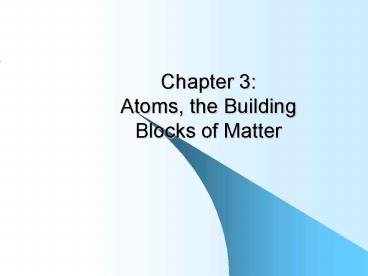Chapter 3: Atoms, the Building Blocks of Matter - PowerPoint PPT Presentation
1 / 22
Title:
Chapter 3: Atoms, the Building Blocks of Matter
Description:
Atoms, the Building Blocks of Matter Atomic Theory has Evolved! Leave a couple of lines! Law of Conservation of Mass Mass is neither created nor destroyed during an ... – PowerPoint PPT presentation
Number of Views:113
Avg rating:3.0/5.0
Title: Chapter 3: Atoms, the Building Blocks of Matter
1
Chapter 3 Atoms, the Building Blocks of Matter
2
Atomic Theory has Evolved!
- Leave a couple of lines!
3
Law of Conservation of Mass
- Mass is neither created nor destroyed during an
ordinary chemical reaction or physical change. - Remember the Candle Lab
- C25H52 O2 E CO2 H2O C
E
4
Draw a picture and explain why it happens?
- Leave about a half a page for an activity
5
Pioneers of the Atomic TheoryChapter 3
- Observant people have been looking at matter and
pondering why different phenomenon occur for
hundreds of years.
6
Early Philosophers- Aristotle and Democritus
- Didnt agree!!
7
Dead Dude 1- Democritus
- Ancient philosopher- 460BC
- Matter is made of indivisible particles.
- Atomos means that which cannot be further broken
down
8
Shortcomings
- It is a conceptual definition, not based on
science. - Doesnt talk about subatomic particles.
9
Dead Dude2- DaltonExplained the Laws
- John Dalton (early 1800s)
- Atom is a solid, indestructible mass (like a
billiard ball)
10
All Atomic Theory builds on Daltons Law
- All matter is made of tiny particles called
atoms. - All atoms of a given element are identical in
size, mass and properties Atoms of each element
are different. - Atoms cannot be subdivided, created or destroyed.
- 4. Compounds consist of atoms of different
elements combined together. Compounds have
constant composition (fixed ratio of atoms). - 5 Chemical reactions involve the rearrangement
of those atoms.
11
Dead Dude 3
- J.J Thomson- 1850
- A ball of positive mass containing a number of
electrons that are embedded. - Getting the idea that there are protons and
electrons (nucleus).
12
Shortcomings
- Doesnt explain the existence of electrons
outside the nucleus or their importance in
bonding. - No neutrons- cant explain radioactivity or the
existence of isotopes.
13
What did experiments with the cathode ray tubes
teach us?
14
Late 1800s
- Discovery of and experiments using the cathode
ray tube led to our understanding of the
electron.
15
Millikan Oil Drop Experiment
16
Henri Becquerel- 1897
- Researched newly discovered X-rays
(Phosphorescence). - Accidently discovered that uranium emits
radiation that could be measured using
photographic plates. - Discovered Radioactivity- electrically charged
particles.
17
The Drs Curie- 1898
- Discovered new elements- Polonium and Radium.
- Very unstable elements that give off energy.
- This led to an under- standing of Alpha, Beta and
Gamma particles.
18
Dead Dude 4
- Rutherford Model- 1905
- Mass of the atom is concentrated in the center of
a positively charged region called the nucleus. - The Planetary Model
19
Gold Foil Experiment- Draw this and leave some
room to write about the experiment.
20
Shortcomings
- Doesnt place the electrons.
- Doesnt include neutrons.
21
Bohr Model-1920
- Believed that electrons traveled in precise
orbits around the nucleus of an atom
22
Schrodinger Quantum Mechanical Model.
- Describes mathematically the wave properties of
electrons and other very small particles
- The nucleus is at the center of the atom and the
electrons are in the electron cloud.

